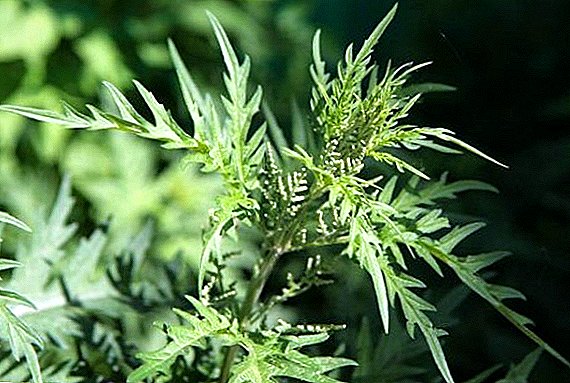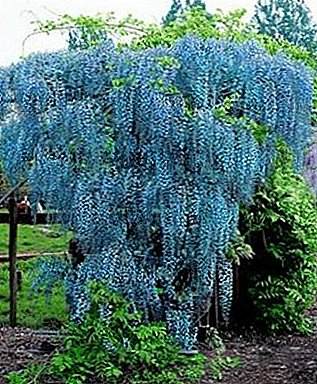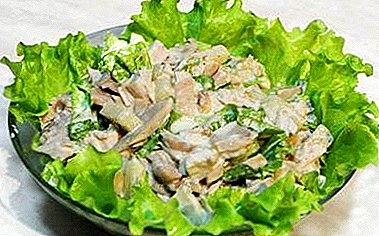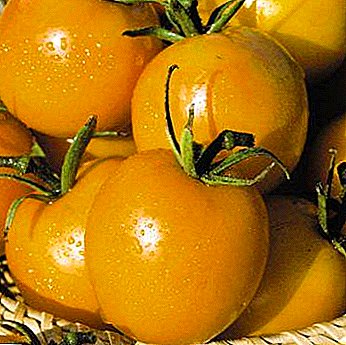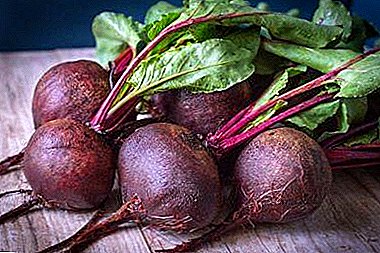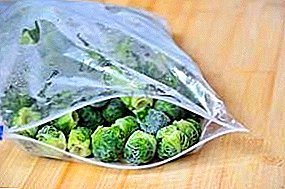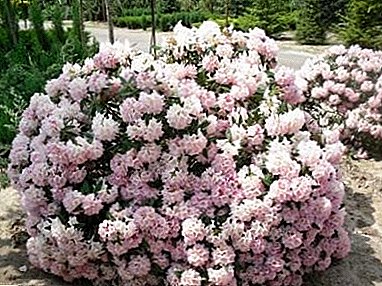 Parsley - the most popular spice with a mass of useful properties, which is widely used in cooking.
Parsley - the most popular spice with a mass of useful properties, which is widely used in cooking.
However, many people associate the plant exclusively with greens, and the parsley root deserves no less attention.
It is for the sake of breeding this part of the plant that the parsley root is grown.
Popular varieties of root parsley
There is a large number of varieties of parsley root, which is a variety of parsley curly. It differs from the leaf variety by a massive root and a smaller amount of green mass. However, this does not mean that green plants are generally not used for food.

They grow crops for the sake of the root, and the greens are more likely to serve the function of feeding the root crop and are involved in the metabolism. If your goal is to grow rhizomes of normal weight and size, it’s better not to pick greens for a salad. Let us dwell on some popular varieties of root parsley.
Did you know? Sometimes people generalize the classification of plants whose rhizome is eaten, calling them all root crops. In fact, the root vegetable - formation, which is formed from the main root and main shoot (carrot, parsley), tuber -a thickening formed on the side shoots of the root (potatoes, Jerusalem artichoke), and the root jar or root cone is a type of adventitious root (dahlia).
Sugar
Known and popular variety, is one of the pioneers of culture. Breeding work on the cultivation of the variety was carried out in the late forties of the XX century. Sugar is not different large root vegetables, but the roots weighing up to 80 g can be harvested within 12-13 weeks after the first growth sprouts in the beds.

The variety is versatile, using the whole plant as a spice. - Root and leaves. As already mentioned, the variety was bred one of the first, so that you can close your eyes to some of the breeders' shortcomings, one of which is the short shelf life.
Alba
The most popular variety of gardeners, differing in late ripening: harvest about 166-168 days after the appearance of the first shoots. The variety has a large rosette, abundant greenery. 
The weight of one root can reach up to 220 g. It has a high yield (up to 4.9 kg per 1 m²) and is perfectly preserved for a long time. The latter quality makes Alba a variety suitable for winter harvesting.
Fruitful
A variety of medium ripening. The vegetation period lasts 125-128 days. The socket is voluminous, the plant stems are directed to the sides, the leaves have a characteristic spicy smell.
Root crops of a typical form for a culture are cone-shaped, have a mass of up to 110-115 g, and are 22 cm in length. Suitable for preservation, cooking first courses, sauces, and eating raw. Under normal growing conditions, up to 3.4–3.6 kg of root crops can be harvested from 1 m².

What is parsley root?
Parsley root is a variety of curly parsley, which is part of the umbrella family. This is a biennial herbaceous plant, reaching 0.9-1 m in height. Stems stretched straight up, foliage green, typical of other plant species. The egg-shaped fruit has an elongated shape. In addition to greens, in cooking, use a large root.
Video: Harvesting Parsley Root
Features of cultivation in the open ground
Among gardeners there is an opinion about the difficulties of growing this variety of parsley, although the stereotype is largely erroneous. Certain features exist, but these are features, not complexities.
These moments include:
- root parsley is not transplanted, since the purpose of breeding is to grow the root, not the greens;
- Before sowing, the seeds are not soaked, because as a result of the procedure, potassium is washed out of them, which can cause poor plant development.
Important! If you ate a dish of garlic and fear for the freshness of breath, parsley root will help you. Chew a small amount of root, and it will destroy the garlic smell.
Landing in the winter
Culture can be winter and spring planting, although many farmers are of the opinion that it is better to sow in the fall. In winter, while in the ground, the seeds are hardened and strengthened, and in the spring, as soon as conditions permit, they awaken and germinate. Moreover, the young growth from such seed material is stronger, has better immunity and brings a harvest earlier.

Choosing a landing site
Place for landing should be chosen based on the following factors:
- the site should be well lit by the sun, however, light shading will not interfere;
- loose soil (in a dense environment, the root grows horned, ugly) with a pH of 6.0-7.0, sandy loam and loam with a large amount of organic matter in composition are better suited;
- groundwater occurrence is not closer than 2 m from the surface;
- we should not forget about the rules of crop rotation: any kinds of cabbage and onions are good predecessors for parsley;
- Pay attention to the neighbors: the most compatible with the culture of tomatoes, carrots, strawberries.
Did you know? In Russia, parsley was grown in the 19th century in the north-western regions, in the suburbs of St. Petersburg and in Eastern Finland, which was then part of the Russian Empire.
Soil preparation
Land for planting begin to prepare around the third decade of October. Soil should be well dig, remove all plant debris. The weeds harvested from the future beds should be carried and destroyed, in order to avoid the development of diseases or attract parasites.

Then you need to make 1/2 bucket of humus per 1 m². From mineral fertilizers make 1 tbsp. spoon of superphosphate and potassium salt per 1 m². In order to obtain a looser substrate, river sand, sawdust or fine gravel are added to it. Shortly before sowing, the ground should be well nourished with water.
Landing technology
Parsley seeds need to be presoaked (stratified) in order to remove the essential oil and stimulate the germination of the crop. However, many gardeners believe that soaking seeds for winter sowing does more harm than good, which is bad for their upcoming winter. Seed consumption for winter sowing is about 50-70% higher than for spring. This is due to the fact that in the spring not all the seeds will sprout, some will die.
Important! Root nEstrushki can not be used during pregnancy, as it has abortive properties. In addition, the product is contraindicated in epilepsy, problems with calcium metabolism and acute renal failure.
In order to maximize the chances of healthy and strong shoots, seed should be prepared as follows:
- Carry out the procedure of vernalization, put the seed in the ice.
- They seed seeds, creating a shell of peat, humus, fertilizers.
- Perform the procedure of hardening, filling the seeds alternately with cold and hot water.
The sowing process is simple and consists of the following:
- In the area where the bed will be broken, the grooves are made with a depth of 3 cm, the distance between adjacent parallel trenches is 0.2 m, the grooves are sprinkled with lime, on the top by sand.
- Trenches are sown with seeds, covered with earth and slightly tamped.
- Sown beds mulch humus.
Plant Care Rules
Care for the root parsley is not difficult. Everything is traditional, however, we will dwell on the main points in more detail.

Fertilization
If you are hoping for a decent harvest of root parsley, be prepared to feed your plantings several times a season. A good option is mineral fertilizers.
The first time they are made shortly after the beds are thinned for the first time. Use this tool: 35-40 g of the complex mineral fertilizer dissolved in 1 bucket of water, pour the resulting solution radical area.
After repeated thinning, the procedure is repeated; a solution of ammonium nitrate (1 tablespoon) and potassium salt (3 tablespoons) in 10 liters of water is used as a top dressing. For the third procedure, wood ash is used, at the rate of 1 item / 1 m².
Find out whether parsley is a vegetable or not.
Watering
The optimal number of irrigation procedures for one growing season is 3-4 times. If spring and summer are dry, water more often, up to 6-8 times. The average rate is 20-25 l / m². The procedure should be performed in the early morning or after sunset.
Thinning
Usually this agrotechnical technique is performed twice. The first thinning is done after the first pair of sheets has been formed. The distance between adjacent shoots should be 4 cm. A repeated procedure is performed after 6-7 leaves appear on the plants, its purpose is to leave the strongest plants every 9-12 cm.

Loosening and weeding
Loosen the soil after any irrigation (watering, rain), and also as needed. Weeds should be removed as they occur. The fewer weeds in the garden, the less likely the development of diseases and the appearance of parasites.
Parsley root is a wonderful spice used in cooking. It has a mass of various qualities used in traditional medicine for the treatment of the urogenital system, the normalization of blood circulation and digestion. Following our recommendations, you can grow it without problems on a personal plot.


